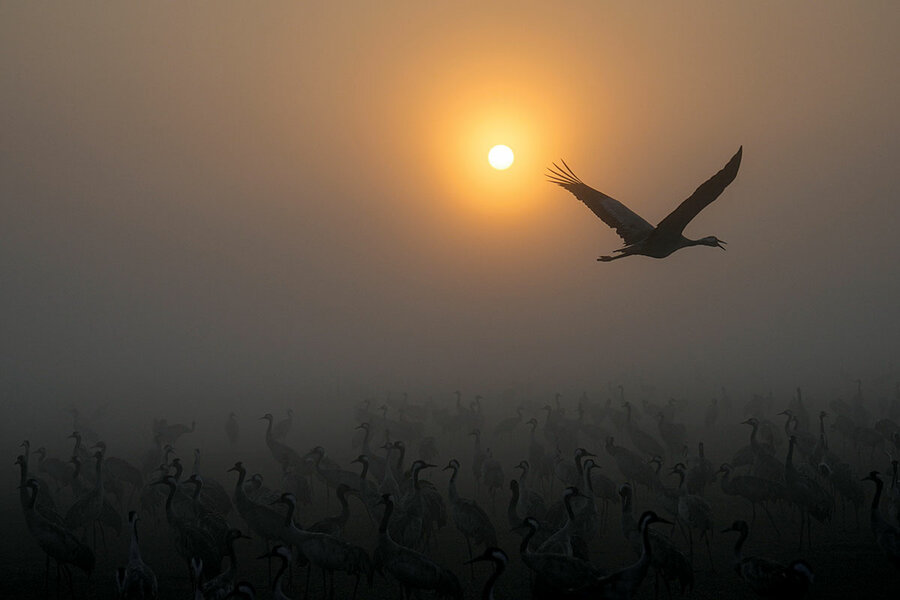Bird migration’s robust history – and fragile future
Loading...
One can’t help but feel a sense of wonder reading about the bar-tailed godwit, a bird the size of a football, whose winter migration can take it from Alaska to New Zealand in one marathon flight across the Pacific Ocean. The ornithologists who’ve helped us understand the phenomenon of migration inspire wonder as well. Their ingenuity and zeal are at the heart of Rebecca Heisman’s delightful debut, “Flight Paths: How a Passionate and Quirky Group of Pioneering Scientists Solved the Mystery of Bird Migration.”
Heisman, a science writer who spent five years working for the American Ornithological Society, begins with an overview of the seasonal movement of birds. Some don’t migrate at all, while others are categorized as either short-, medium-, or long-distance travelers. “Flight Paths” focuses on the latter, birds that, once the urge to migrate is triggered, travel for improbably extended stretches, “chasing booms in the availability of insects and other key foods and the right conditions to nest and raise babies.”
From there, the author proceeds chronologically, an astute choice that enables readers to appreciate how far scientists have come in understanding birds’ incredible journeys. We’re a long way from the 17th-century educator who was certain that birds migrated to the moon. The “gentleman ornithologists” the author features at the beginning of the book would regard more recent technological advances in tracking avian movement as the stuff of science fiction.
One significant method of studying birds, banding, has deep roots and is still popular today. Birds are gently captured in fine-meshed mist nets, and small numbered rings are attached to their legs in an attempt to trace their movements after release. While only a minute fraction of banded birds are found again, Heisman notes that the U.S. Geological Survey Bird Banding Laboratory annually distributes a million bands, so the numbers add up, yielding useful insights. Years of data have helped researchers determine that many birds are adjusting their migration schedules in response to climate change.
More modern methods for tracing birds include Doppler radar, satellite, and GPS tracking, and DNA analysis of feathers. Heisman’s summaries of these advances are brimming with captivating stories of the men and women behind them. In 1973, Bill Cochran, an important innovator in wildlife telemetry, and his student Charles Welling, attached a tiny radio transmitter to a Swainson’s thrush and then hopped into their vehicle, tricked out with a large antenna, to pursue it for nearly a thousand miles over “seven madcap nights.” Cochran was also known to chase after birds in his small plane.
The author writes in a clear, breezy style, and she’s adept at explaining scientific principles to laypeople. An avid birder herself, she expresses her own sense of awe of both the birds and the scientists who’ve unlocked their secrets. She describes the process by which geolocators recorded the extreme migration of a blackpoll warbler, a small bird that she notes weighs about as much as a AAA battery. Of the warbler’s 72-hour, 1,400-mile flight toward South America, she marvels, “For three days and three nights, a bird that could sit in the palm of your hand beat its wings without ceasing, with nothing below but the endless blue and gray and green of the ocean.”
Heisman’s upbeat tone, however, doesn’t keep her from conveying the formidable threats facing avian populations. A 2019 study in the journal Science grabbed headlines and raised alarms with the shocking finding that the number of birds in North America had declined by 3 billion in the last 50 years, a drop largely attributed to habitat loss and pesticide use. “I’ve occasionally wondered, while writing this book, if all of these new technologies allowing us to understand the intricacies of migration with greater clarity than ever before are actually just helping us document, in excruciating detail, the final decline of one of the natural world’s most inspiring phenomena,” the author writes ruefully.
In the end, however, Heisman finds reason for hope – not just in the work of scientists, but in the committed efforts of a global community of bird-watchers and environmental activists. Their activities include participating in annual bird counts and contributing to the crowdsourced platform eBird, which provides real-time bird observations. More information on where birds are (and aren’t) going will help scientists pinpoint where the problems exist, in turn helping to create a path to solutions.








